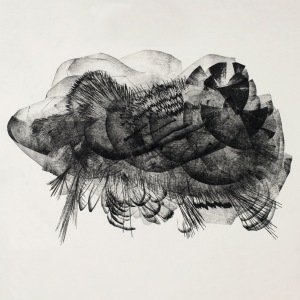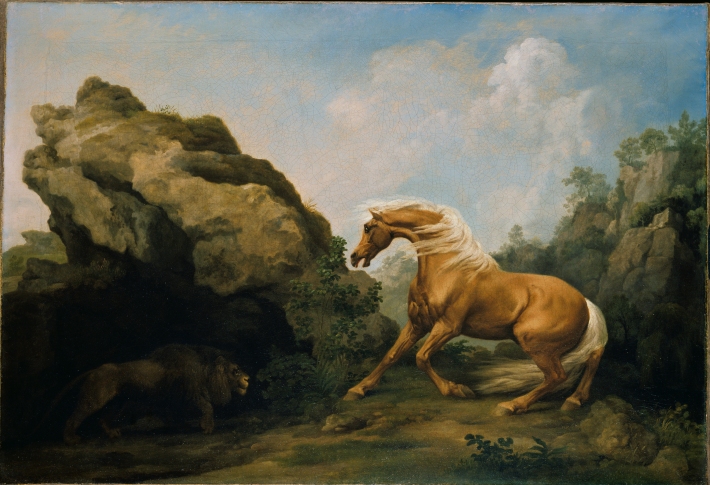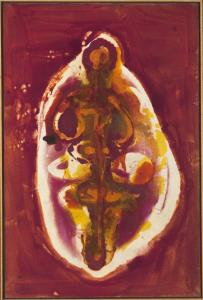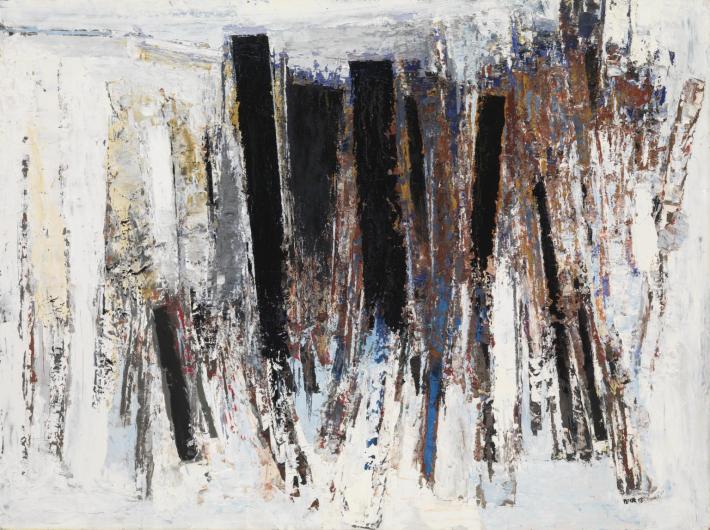After releasing three EPs in successive years, String and Tins Recordings is set to release The Stills Series on vinyl, collecting all three EPs and adding a new Joe Wilkinson remix of Simon Whiteside’s “Immersions.” To celebrate, and to draw new attention to this unique project, we’ve just combined our first three EP reviews in one massive article, art intact, adding this new introduction!
 Here’s a unique idea: ask sound designers to look at works of art and imagine them as movie stills. Then ask the composers to score the subsequent scenes. A trio of artists from the String and Tins family selected works from London’s Britain Tate Gallery for the first in a series, and the results are exquisite, opening new modes of viewing, thinking and hearing.
Here’s a unique idea: ask sound designers to look at works of art and imagine them as movie stills. Then ask the composers to score the subsequent scenes. A trio of artists from the String and Tins family selected works from London’s Britain Tate Gallery for the first in a series, and the results are exquisite, opening new modes of viewing, thinking and hearing.
Jim Stewart chooses Paul Nash’s oil painting Totes Meer (Dead Sea), which was inspired by photos Nash took of an aircraft dump. Nash writes, “The thing looked to me suddenly, like a great inundating sea … something static and dead.” Stewart responds with processed piano and horns, presenting a broken, hollowed soundscape that bobs and weaves on sonic waves of sorrow. The slow glissandos are like planes falling to their deaths: the suspended time before collision and the shattered time after, excising the crash itself. The sounds of creaks and dragged glass bring the painting to life; while watching and looking, one can imagine animation.
Mary Martin’s abstract Inversions is the subject of Simon Whiteside’s piece. Martin’s fascination with architecture inspired the creation of 96 aluminum panels, the second 48 an inversion of the first. An additional inversion is provided by the reflection of the in-person viewer. Whiteside’s notes (far more than 96) sound as if they, too, could be placed in boxes; the staccato strings mimic the rigid architecture, while the fluid strings mimic the morphing reflections. As with Stewart’s piece, the tension grows throughout the span of the composition. As to what sort of scene the still is from, the question is wide open; could the scene be taking place inside the museum, instead of the region of construction?
And then there is The Annunciation, the most straightforward of the artworks. Or is it? According to infrared photography, there was once another woman behind Mary; and the painting was inspired by the non-canonical Gospel of James. Joe Wilkinson captures the mystery of the oil painting with the slightly changed title of “Annunciations,” starting with choir and light drone and progressing to a sense of gentle wonder. The bells and mallets that enter mid-piece produce a feeling of energy that matches our estimation of Mary’s reaction.
These Tate artists are long gone, but one wonders what their reaction would be to these works. One would hope their descendants are pleased at the reverence shown toward these works, as well as the effort to bring appreciation to new audiences. It’s only fair to mention a fourth work: Camille Rousseau’s cover, which carries the project a step further. This physical image reflects sonic images based on other physical images: an usual chain of influence that sparks a new idea: what if Stills 02 were to begin with a reaction to Rousseau’s work?
 String and Tins Recordings continues its Stills series with a second volume of compositions that ask the question, “How would you score a work of art?” A quartet of composers were invited to adopt a work from London’s Tate Britain Gallery and to compose a corresponding score. Combined with Stills 01, the project is now nearing album length, suggesting that a hybrid art book/record or CD might be forthcoming.
String and Tins Recordings continues its Stills series with a second volume of compositions that ask the question, “How would you score a work of art?” A quartet of composers were invited to adopt a work from London’s Tate Britain Gallery and to compose a corresponding score. Combined with Stills 01, the project is now nearing album length, suggesting that a hybrid art book/record or CD might be forthcoming.
“Carnation, Lily, Lily, Rose” has now come full circle, its title inspired by a popular song of the 1880s. The impressionist painting nudged its way to completion a few minutes each dusk, John Singer Sargent seeking to communicate the awe of paper lanterns hung at night. Enter Mike Bamford, who recreates the time of day with nighttime insects and tender piano. The simple melody honors sisters Dolly and Polly, happily lost in the act of decoration. As the strings take over, they convey a sense of childhood innocence, with only a smidgen of melancholy; these days may not last, but a painting can preserve them forever.
George Stubbs’ “Horse Frightened by a Lion (1763)” is a dramatic image already in full motion. This is one of eighteen painting in Stubbs’ series, dramatically topped with “Horse Devoured by a Lion.” Knowing the fate of the noble animal changes one’s appreciation of the painting: here is the noble animal, intact for the final time. Adam Smyth contributes filmic foreboding from the very first moment, drums sounding a death march while strings encapsulate the drama. The lighter middle melodies recall the horse’s happier times, as if in a flashback montage. One is already thinking of the conflict and the climax. A hero’s motif emerges in the closing minute; this horse may be unnamed, but will not be forgotten.
Henry Wallis’ “Chatterton (1856)” depicts the 17-year-old romantic poet lying dead after taking arsenic. The painting splits allegiances. On the one hand is the futility of young, promising life taken too soon and unnecessarily, the open window a sign of the soul escaping, or a promise that things might have gotten better. On the other hand, what a pretty corpse, perfectly positioned in a pretty room: a romanticizing of suicide that excises the ugliness and recrimination. The composer Kasper Broyd attempts to capture all this in under three minutes, a trumpet fanfare joined, then supplanted by strings: a funeral procession or a celebration of the thin slice of life enjoyed by the poet. As Broyd writes, different listeners may pick up on different facets of the theme, an elegant sadness, a noble tragedy.
The blood red color of Magda Cordell’s “No. 12 (1960)” suggests blood, the internal shape a body, a womb, a birth canal. There’s little escape from the confrontational nature of the art, which seems to demand comment. Is blood a tribute to ancestors and the earth, or a fluid that prompts aversion? Across history and culture, how much have women been forced to endure? Are they now reclaiming their power? Lawrence Kendrick begins with lonely piano, intimating the soul alone, then adds gentle, comforting accompaniment. The piece builds, then recedes, the cycle of life, quiet at the edges and furious in the middle.
When you look at art, what do you hear? These composers appreciate the twist in the question. If a picture is worth a thousand words, it may well be worth a symphony as well. As film stills, these small scenes lend themselves well to aural interpretations, prompting observers to participate in a voluntary form of synaesthesia.
 With Stills 03, London’s Strings and Tins collective completes its Tate Britain trilogy, in which each track imagines a painting as a film still in search of a score. Artists were given carte blanche to wander around the London gallery and to choose their own subjects, which makes each piece a labor of love. Together, the EPs are long enough to form an album, which we hope will be produced and sold in the lobby, perhaps with an eleventh track inspired by the cover art of Camille Rousseau.
With Stills 03, London’s Strings and Tins collective completes its Tate Britain trilogy, in which each track imagines a painting as a film still in search of a score. Artists were given carte blanche to wander around the London gallery and to choose their own subjects, which makes each piece a labor of love. Together, the EPs are long enough to form an album, which we hope will be produced and sold in the lobby, perhaps with an eleventh track inspired by the cover art of Camille Rousseau.
Briton Rivière had never been to the Arctic, but was fascinated by the exploits of the explorers. “Beyond Man’s Footsteps” is nearly surrealistic, as befits the product of a keen imagination; glacial structures jut and curl as a red sun sets against a violet background beneath an amber sky. The lone polar bear sets the template for “The Lion King”s famous image, which would arrive a century later. Ironically, the bear is based on one seen at the London Zoo.
By adapting the scene, Will Cohen underlines the leaps taken by the Stills series. Just as Rivière speculates about the landscape, Cohen speculates about Rivière and his creation. The track starts in synthetic isolation, as dark ambient drippings precede the entrance of majestic strings. First arrives a swiftness, and then a slowness. While the colder sounds return; the other instruments are never again as ebullient, coalescing into a somber elegy. Rivière “looks” at the Arctic for its beauty; Cohen imagines its demise. And what do we feel when we hear the musician, looking at the art, from an artist who imagined his scene?
“The Soul of a Soulless City” (which was originally titled “New York – an Abstraction”) heads in the opposite temporal direction. In 1920, the prophetic Christopher Richard Wynne Nevinson imagined a jam-packed city, in which the skyline was barely visible. The rising railway, which seems to curve directly into a building, is an emblem of progress, the Futurist design a sign of its times. Nevinson would later grow disenchanted with the city, and Jim Stewart seeks to capture this dichotomy of hope and disappointment. The words “last stop on this train” are repeated, first robotic, then human, then stuttered, a blur of presentations that may represent the turning of technology. The music shifts from jazz to modern composition. The tone grows warm, then cools again. In the warm section, even the words become welcoming: “All aboard!” In the third minute, ev-ery-thing-slows: the train, the track, the progress. The early words return. A piano cries. New York City is many things to many people; as Grandmaster Flash & the Furious Five rap, “New York, New York, big city of dreams, but everything in New York ain’t always what it seems.” Stewart never regained his enchantment, but Stewart restores it in a kind, posthumous manner.
Paul Feiler’s “Morvah” (1958) may suggest disconnected piano keys or birch trees in winter, but is inspired by “the sea and the rocks seen from a great height.” Simon Whiteside‘s interpretation is the most cinematic of the entire series, the right note on which to close. The dramatic, propulsive music begins like a frigate chase and turns into a battle on a raging sea. Wild strings dance among caffeinated brass until a mid-piece crash reveals a harp, chimes, a romantic sub-theme like a stolen kiss between conflicts. Feiler looks at the sea and sees lines; Whiteside looks at the lines and hears crescendos; we hear the crescendos and think of movies. The music has accomplished what it set out to do, turning paintings into stills, then pressing Play. (Richard Allen)










